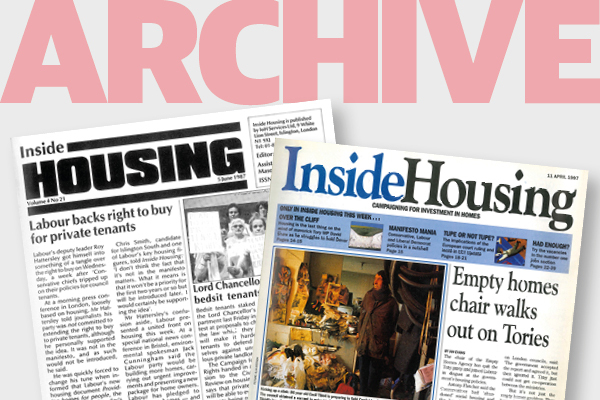You are viewing 1 of your 1 free articles

It matters how much space we have to live in
There is a growing disparity in living space, says Colin Wiles, and incentives are needed to encourage people to downsize
After the Russian Revolution, the Soviets nationalised most housing, and living space was allocated by government diktat according to need, with a fixed quota of space for each person. Large apartments and houses were subdivided into smaller spaces with families forced to share kitchens and bathrooms and commissars enforced the rules.
“Well-off owners are occupying more and more space, while renters, especially younger renters, are occupying less”
In the UK we rarely talk about the space occupied by each person. It’s a bit like discussing salaries, and the notion of local bureaucrats sniffing out spare bedrooms and billeting people into unused space would be anathema to the British public (although the bedroom tax has to be seen as a rather Soviet version of space control).
However, there is a debate to be had about this topic, as there are wide disparities in the amount of living space we occupy with deep divisions based on age, income, race and class. This is the theme of my latest report for the Intergenerational Foundation: Stockpiling Space: how the pandemic has increased housing inequalities between older and younger generations.
The key theme of the report is that well-off owners are occupying more and more space, while renters, especially younger renters, are occupying less. According to the English Housing Survey, it is estimated that 52% of owners now under-occupy their homes – up from 48.7% in 2011.
By contrast, the percentage of social and private renters who under-occupy their homes declined over the past decade – from 10.3% and 16.6% to 8.7% and 14.4% respectively. Renters also became more overcrowded – around 7% of renters live in overcrowded properties, compared with only 1% of owners.
Research by the Greater London Authority also showed that floorspace per person has been increasing for owners and decreasing for renters.
“Renters have less access to open space, are more likely to suffer depression and anxiety, and most likely to have lost their jobs or been furloughed”
Since 1996, floorspace per person has increased for all owners, whereas the average floorspace enjoyed by social housing residents fell from 28.4m2 in 1996 to 27.5m2 in 2018 and from 34.1m2 to 28.6m2 for private sector tenants.
We have also seen significant increases in second homes and investment properties over the past two decades, with baby boomers being the main beneficiaries.
In short, renters are being forced into less space and owners are enjoying more space.
The pandemic has exacerbated these inequalities in living space, with renters suffering disproportionately from coronavirus deaths, hospitalisations and the wider impacts of lockdown. Renters have less access to open space, are more likely to suffer depression and anxiety, and most likely to have lost their jobs or been furloughed.
Furthermore, owners, particularly older owners, have been buying up more space over the past year. The demand for country and coastal properties has increased; Londoners have been on a spending spree, buying up country and coastal properties; and larger, more expensive properties have been disproportionately bought by older buyers.
“Only 3% of the nation’s housing comprises bespoke retirement properties, yet almost a quarter of the UK population will be over 65 within a couple of decades”
What, if anything, can be done about these inequalities? To begin with, we need to address some of the factors that encourage owners to under-occupy. For example, the council tax regime is regressive (people in smaller properties pay proportionately more) and there are wide disparities across the country.
The single-person discount encourages people to under-occupy and should be scrapped. Stamp duty discourages people from downsizing and is a major barrier within the secondary housing market. Although the current stamp duty holiday is misguided, it would make sense to scrap the duty for people who downsize from larger to smaller properties.
But the lack of suitable retirement properties is also a major factor. It’s estimated that only 3% of the nation’s housing comprises of bespoke retirement properties, yet almost a quarter of the UK population will be over 65 within a couple of decades. Tweaks to the planning system could address this. For example, the National Planning Policy Framework could put a duty on local authorities to assess the level of under-occupation within their areas and set targets for retirement homes.
Another policy change could be to put retirement housing on a par with affordable housing when looking at rural exception sites and extend this to urban areas, with marginal and infill sites receiving permission for retirement homes alone.
We need to build many more homes, and we should never accept that reallocation of housing space is the only solution, or allow nimby campaigners to argue that new homes are not required because enough living space is available for everyone. But according to Les Mayhew, professor of statistics at Cass Business School, if “people lived in homes more suited to their needs, 50,000 fewer homes would need to be built each year”.
It would, of course, be wrong to use coercion against people who are under-occupying their homes, but there’s much more we could do to encourage and incentivise under-occupying owners to downsize and make them believe that it’s the ‘right’ and ‘moral’ thing to do.
Colin Wiles, independent housing consultant











